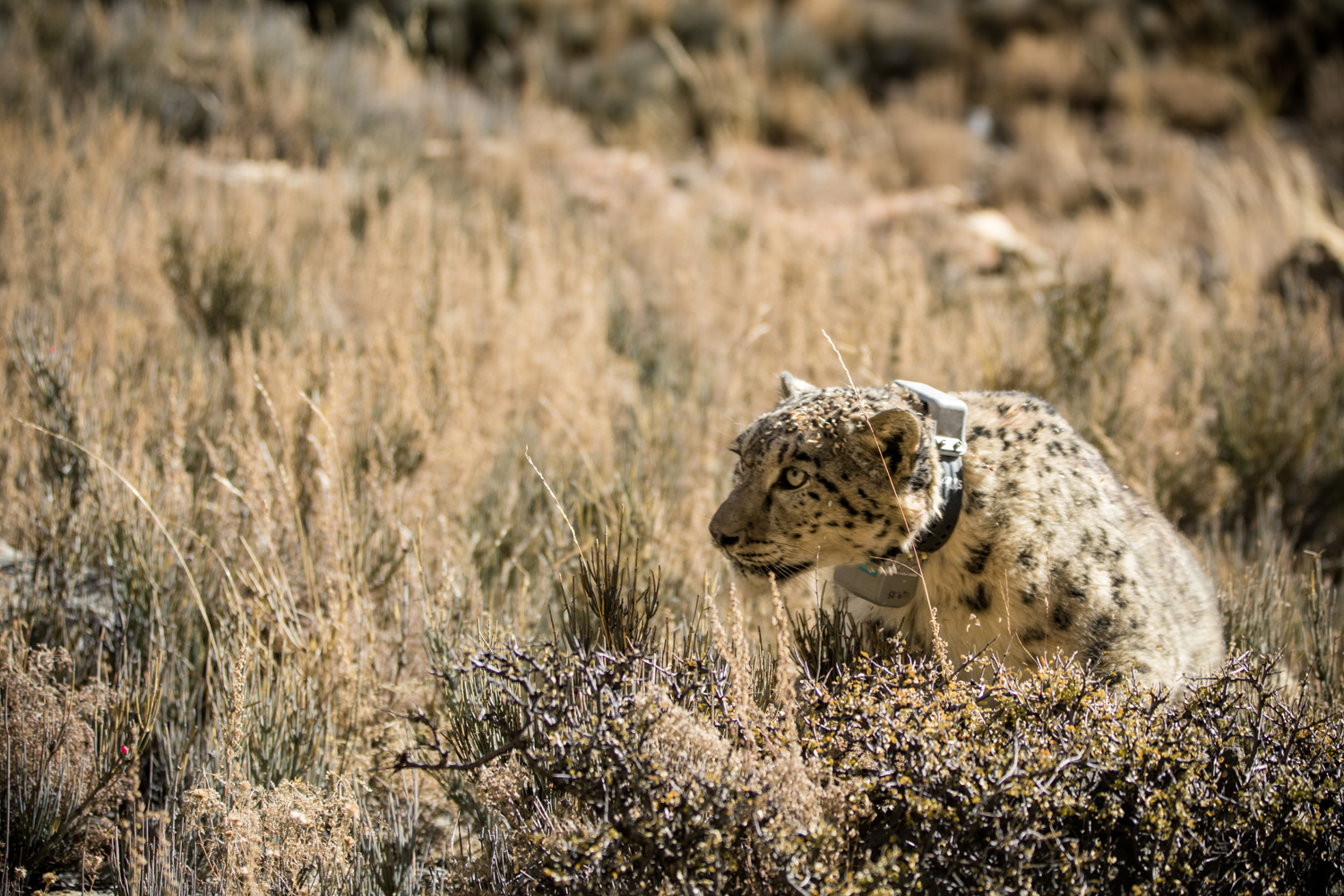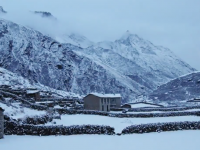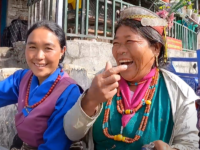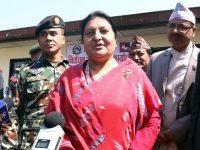Kathmandu, Nepal – Two snow leopards were successfully collared in mid-November in Bhijer of Shey Phoksundo National Park in Karnali Province of Western Nepal.
Captured at 4171 meters in Charkarbo, the first snow leopard was named Zeborong after the local Snow Leopard Conservation Committee in the region. This handsome mammal weighs 38 kgs. Meanwhile, locals chose to name the second one Samling. Shyamling Gumba happens to be the oldest monastery in Dolpa and this is how this elusive creature got its name. Shyamling was captured at 3885 meters in Ngyong and weighs 33 kgs. Both the adult males were captured inside the park and fitted with a satellite-GPS collar and, released back into the wild an hour later.

“The Western Himalayan Landscape is a priority landscape, with Dolpa having the largest snow leopard population in Nepal. And the use of satellite telemetry collaring in research and monitoring will help in the conservation of these iconic species in the landscape,” stated Dr. Bishwanath Oli, Secretary, Ministry of Forests and Environment.
Meanwhile, Mr. Gopal Prakash Bhattarai, Director General, Department of National Parks and Wildlife Conservation stated that, “The data generated from these collars will be crucial in understanding the spatial ecology of snow leopards in this landscape while also bridging the existing information gaps in the Western Himalayan Landscape.”

This is the first time that a satellite telemetry expedition has been undertaken in the Western Himalayan Landscape, after Wildlife Biologist, Dr. Rodney Jackson’s scientific radio collaring mission in the 1980’s to track snow leopards and learn about their habitats.
Following the collaring, both Zeborong and Shyamling will be closely monitored by the government, and conservation biologists. With almost no data from this terrain, conservationists are hopeful that the information received from the recent collaring, almost 40 decades later will help determine snow leopard movement patterns, habitat use and preferences, and home ranges in western Himalayas to identify critical habitats and corridors between them, including trans-boundary habitat linkages and climate resilient habitat for future conservation.
Dr. Ghana S. Gurung, Country Representative of WWF Nepal said, “With growing infrastructural development across the country, information received from the collaring will be key in identifying implications of linear infrastructure in snow leopard habitats, human-snow leopard interface and mitigation measures. Furthermore, besides contributing towards the Global Snow Leopard and Ecosystem Protection Program (GSLEP), the data will also help determine how snow leopard conservation moves ahead in Nepal in the face of climate change.”
The collaring expedition was led by the Government of Nepal in partnership with WWF Nepal, National Trust for Nature Conservation, and citizen scientists from the local Snow Leopard Conservation Committees. WWF-UK, WWF Belgium, WWF Canada and WWF Australia, WWF Nepal provided financial support for the collaring.
About WWF
WWF is the world’s leading conservation organization, working in 100 countries for nearly half a century. With the support of almost 5 million members worldwide, WWF is dedicated to delivering science-based solutions to preserve the diversity and abundance of life on Earth, halt the degradation of the environment and combat climate change. WWF has been active in Nepal since the 1960s and remains committed to the vital work being done in the region to save its unique and irreplaceable biodiversity.
Learn more at www.wwfnepal.org
नेपालको संरक्षण क्षेत्रमा अर्को कोशेढुङ्गा, दुइटा हिमचितुवामा सफलतापूर्वक ‘भू-उपग्रह कलर’ जडान
काठमाडौं, नेपाल – कर्णाली प्रदेशमा रहेको श-फोक्सुन्डो राष्ट्रिय निकुञ्जको भिजेरमा मङ्सिरको पहिलो साता दुई हिमचितुवामा सफलतापूर्वक ‘भू-उपग्रह कलर’ जडान गरिएको छ ।
समुन्द्री सतहबाट ४१७१ मिटरको उचाईमा समातिएको पहिलो हिमचितुवालाई यस क्षेत्रको स्थानीय हिउँ चितुवा संरक्षण समितिको नामानुसार ‘जेबोरोङ्ग’ नामाकरण गरिएको छ । यस सुन्दर स्तनधारी ३८ केजी तौलको छ । यसैबीच, स्थानीयहरूले दोस्रो हिमचितुवाको नाम ‘स्याम्लिङ्’ राखेका छन्, जसको नाम डोल्पा जिल्लाको सबैभन्दा पुरानो स्याम्लिङ् गुम्बाको नामबाट राखिएको हो । स्याम्लिङ्लाई समुन्द्री सतहबाट ४१७१ मिटरको उचाईमा समातिएको थियो भने यसको तौल ३३ केजी रहेको छ । दुबै वयस्क भालेहरू निकुञ्ज भित्रै समातिएका थिए र भू-उपग्रहसँग सीधा सम्पर्क भएको ‘जीपीएस कलर’ घाँटीमा जडान गरी एक घण्टा पछि उनीहरुकै बास्थानमा छाडिएका थिए ।
“पश्चिम पहाड भू–परिधि प्राथमिकतामा रहेको एक भू-परिधि हो जसमा डोल्पामा नेपालकै सबैभन्दा बढी हिमचितुवाको संख्या रहेको छ । ‘भू-उपग्रह टेलिमेट्री कलरिंग’ को प्रयोग गरी अनुसन्धान र अनुगमनमा गर्नाले यस विशिष्ट प्रजातिको संरक्षण गर्न मद्दत पुर्याउनेछ” वन तथा वातावरण मन्त्रालयका सचिव डा. विश्वनाथ ओलीले बताउनुभयो ।
यसैबीच, राष्ट्रिय निकुञ्ज तथा वन्यजन्तु संरक्षण विभागका महानिर्देशक गोपाल प्रकाश भट्टराईले भन्नुभयो, “यी कलरहरूबाट प्राप्त तथ्याङ्क यस भू-परिधिमा रहेका हिमचितुवाको स्थान-विशेष पर्यावरणका बारेमा बुझ्नका लागि महत्वपुर्ण हुनेछ साथै यस पश्चिम पहाड भू–परिधिमा हाल विद्यमान सूचनाको कमीका समस्यालाई न्यूनीकरण गर्न मद्दत पुर्याउने छ ।
पश्चिम पहाड भू–परिधिमा वन्यजन्तु जीवविज्ञ डा. रड्नी ज्याक्सनद्वारा सन् १९८० को दशकमा हिमचितुवाहरूको बानी-व्यहोराका बारेमा जानकारी लिनका लागि ‘बैज्ञानिक रेडियो कलर अभियान’ सञ्चालन गरे पश्चात यस भ-परिधिमा अहिले पहिलोपटक हो ‘भू-उपग्रह टेलिमेट्री अभियान’ सञ्चालन भएको हो।
कलर जडान गरे पछि जेबोरोङ्ग र स्याम्लिङ् दुबैलाई नेपाल सरकार र संरक्षण जीवविज्ञहरूद्वारा निकट रुपमा अनुगमन गरिनेछ । यस भू-भागबाट लगभग कुनै तथ्याङ्क हाल उपलब्ध नभएकाले झन्डै चार दशक पश्चात भएको यस कार्यबाट प्राप्त हुने सूचनाले हिमचितुवाको हिँडडुलको तरिका, बासस्थानको प्रयोग र प्राथमिकताहरू, र पश्चिमी हिमालयमा यस प्रजातिको आवास-क्षेत्रबारे जानकारी प्रदान गर्ने, जसका माध्यमबाट भविष्यमा संरक्षणका लागि महत्वपुर्ण बासस्थान र जैविकमार्ग पहिचानका साथै अन्तर्देशीय बासस्थान र जलवायु उत्थानशील बासस्थान पहिचान गर्न मद्दत पुग्ने कुरामा संरक्षणविद्हरू आशावादी छन् ।
डब्लुडब्लुएफ नेपालका राष्ट्रिय प्रतिनिधि डा. घनश्याम गुरुङ्गले भन्नुभयो, “देशभरि बढ्दो पूर्वाधार बिकाससँगै कलरिंगबाट प्राप्त सूचना हिउँचितुवाको बासस्थानमा पूर्वाधार बिकासले पारेका प्रभावहरु, मानव-हिमचितुवा बीचको सम्बन्ध र न्यूनीकरण उपायहरु पहिचान गर्न महत्वपूर्ण हुनेछ । यसबाहेक, विश्वव्यापी हिमचितुवा तथा पर्यावरण संरक्षण कार्यक्रम (जीएसएलइपी) लाई योगदान पुर्याउनुका साथै जलवायु परिवर्तनका बीच नेपालमा हिमचितुवा संरक्षण कसरी अगाडि बढ्नेछ भन्ने कुरामा पनि महत्वपुर्ण भूमिका निर्वाह गर्नेछ ।”
नेपाल सरकारको नेतृत्वमा सञ्चालन भएको यस अभियानमा डब्लुडब्लुएफ नेपाल, राष्ट्रिय प्रकृति संरक्षण कोष र स्थानीय हिमचितुवा संरक्षण समितिका नागरिक वैज्ञानिकहरूको साझेदारी रहेको थियो। डब्लुडब्लुएफ-युके, डब्लुडब्लुएफ बेल्जियम,डब्लुडब्लुएफ क्यानडा र डब्लुडब्लुएफ अष्ट्रेलियाद्वारा यस कार्यका लागि आर्थिक सहयोग उपलब्ध गराइएको थियो ।






















